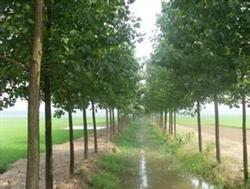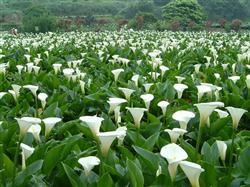Common diseases of poplar in spring

Poplar canker mainly occurred in the process of seedling transplantation. the disease began in late March, peaked from mid-April to late May, stopped at the beginning of June, and developed slightly after October. The disease can infect tree trunks, rhizomes and branches of big trees, but mainly harms the middle and lower parts of the trunk. In the early stage of the disease, blisters appeared near the lenticels of the trunk, and there were a large number of bacteria in the broken blisters. Finally, the part of the disease shrinks and sinks into ulcer spots, and the cortex of the lesions turns brown and rotten. When the lesion expands horizontally around the trunk, the tree dies. Poplar is easy to get sick when it is weak. Control methods: ① selected strong seedlings for afforestation, tried to avoid root injury when raising seedlings, and kept moisture when transporting pseudo-planting. The roots of ② were stained with ABT3 rooting powder solution before planting, and the bottom water was poured during planting. After planting, 1000-fold solution of 5406 cytokinin was sprayed on the young tree cadres. In spring, ③ applied white coating on the lower part of the tree trunk, or sprayed it with 0.5 Baumetu stone sulfur mixture, or sprayed with Bordeaux 160 solution to prevent trunk infection and reduce the incidence of disease. If the incidence is more than 50%, drying will not have an obvious effect, but flat stubble. The black spot disease of poplar began to occur in early May and reached its peak in summer and autumn until the leaves fell. It can harm poplar leaves, petioles, fruit ears, tender shoots, etc., forming angular, near-round or irregular black-brown spots with a diameter of about 1 mm, some up to 5 mm. Disease spots can be connected into irregular large spots for a long time, causing early defoliation. Control method: ① breeding disease-resistant poplar varieties. During the onset of ②, nurseries and young forests were sprayed with 200x Bordeaux solution or 85% Dyson zinc 250x solution. Reasonable close planting and timely thinning of ③ can keep the forest ventilated and transparent. Clean up the fallen leaves in the forest in time to reduce the source of the disease. ④ can spray 40% carbendazim 800x solution, or 25% chlorothalonil 600x to 800x solution, or 0.3% urea and potassium dihydrogen phosphate mixture in early June. The disease of poplar leaf blight starts from poplar leaves and harms poplar leaves, young shoots and young stems, and the affected leaves are the most susceptible from May to June. Nearly round, polygonal or irregular plaques appear on the damaged leaves, with a diameter of 1 to 5 mm, which can be connected into large spots. There is a dark brown mildew on the spot. The disease spots on the tender shoots and stems are sunken and prismatic, with a green mildew layer on them. Prevention and treatment methods: ① starts from the onset of the disease and carries out chemical control. It can be sprayed 2 to 3 times in the whole growing season, and can be treated with 40% ethyl phosphate aluminum 300x solution, or 75% chlorothalonil 500x solution, or 50% carbendazim 1000 times solution. ② removed dead branches and leaves in time, and took them out of the forest to burn or bury them to make fertilizer, so as to reduce the source of bacteria. Poplar rot mainly harms the branches and branches of poplar, and the disease spot is irregular in shape and size. At the beginning of the disease, the disease spot is dark brown, water stains, and then dehydration shrinks and sinks, sometimes the disease spot cracks into a filamentous shape. In the later stage, there are many small black spots on the disease spot. When wet, curly, orange filaments can grow from the small black spots of the disease spot. The disease spot expands outward every year, when encircling the branches, the upper branches and stems will all die. In the years with heavy precipitation in spring and summer, the incidence of rot is serious. Prevention and treatment methods: scrape off the disease spot with a knife in ①, scrape it to the health department, and then apply 10 times of edible alkali water or 10 times of 20% agricultural antibiotic 120 water agent on the disease spot for 2 to 3 times. ② in spring or autumn, apply a white coating on the lower part of the tree trunk, and the proportion of quicklime, salt and water is 1. 3. 3 and 10.
- Prev

Pot culture methods and matters needing attention of rhododendron
Rhododendron, also known as Yingshanhong and pomegranate, is an evergreen or ordinary green shrub with luxuriant and colorful flowers blooming in spring. Azaleas have always been a favorite flower. I think many people have raised azaleas. Many people may not know the breeding methods and points for attention of azaleas.
- Next

How to control the diseases of calla lilies
The main pests that harm calla lilies are: two-point spider mite, that is, cotton spider mite and cotton red spider. The back of Tetranychus urticae is oval, the back of male is rhombus, the color in spring and summer is yellow and yellowish green, there is a black patch on each side, and the body color becomes orange by the end of summer.
Related
- Fuxing push coffee new agricultural production and marketing class: lack of small-scale processing plants
- Jujube rice field leisure farm deep ploughing Yilan for five years to create a space for organic food and play
- Nongyu Farm-A trial of organic papaya for brave women with advanced technology
- Four points for attention in the prevention and control of diseases and insect pests of edible fungi
- How to add nutrient solution to Edible Fungi
- Is there any good way to control edible fungus mites?
- Open Inoculation Technology of Edible Fungi
- Is there any clever way to use fertilizer for edible fungus in winter?
- What agents are used to kill the pathogens of edible fungi in the mushroom shed?
- Rapid drying of Edible Fungi

